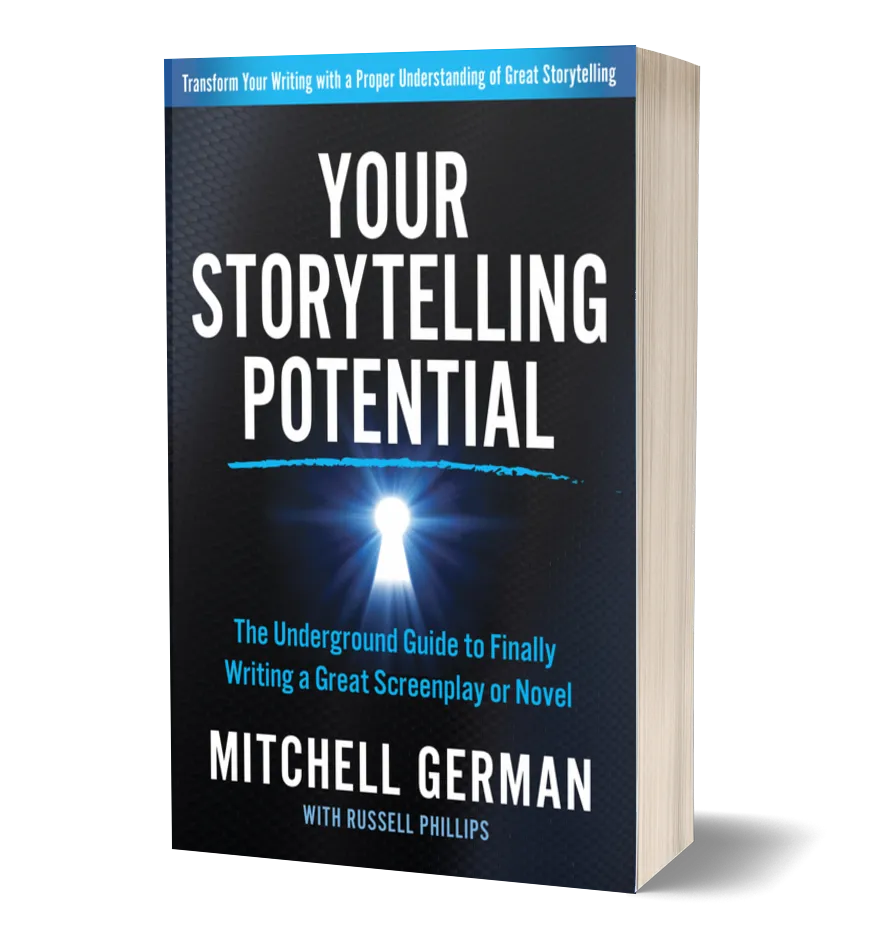
Unlock Your Story's Full Potential
Get clear, specific, relevant, and actionable rewrite notes, specific suggestions, and directed changes that are needed so that your Next Draft Will Be Your Last & Final Draft.
This is NOT "script coverage" and it's NOT a basic "review" service.
The Max Impact Script Review focuses on providing clear and unmistakable advice to help make sure your NEXT DRAFT IS YOUR LAST & FINAL DRAFT!
Most other coverage and review services simply give you a short overview of your existing work (as if you don’t already know what it says), an opinion about that work, and very general notes about what might be wrong with any given screenplay or novel.
Our review services are NOTHING like that. Our goal is to make sure Your Next Draft Is Your Last & Final Draft!
We provide in depth analysis about WHY certain things work, and WHY other things don’t, and then most importantly, the Max Impact Script Review provides detailed and comprehensive suggestions about HOW to fix things.
The Max Impact Review: Read, Rate & Review Screenplay and Novel Evaluation (Level 1)
No Other Review Service Will Provide You With This Much Clarity About What To Do Next.

Mitchell German will personally read your screenplay and provide detailed analysis about what works, what doesn't, and what you can do to fix it.
Mitchell's unique and detailed analysis utilizes the comprehensive Your Storytelling Potential approach to the essential A/B Story Relationship and a Plot Control breakdown of your Core Elements and Story Structure. This unique approach to screenplay and story assessment shines a clear light on what is missing from any story.
Mitchell then provides a clear breakdown of his findings along with a comprehensive list of action steps and detailed suggestions based on SIX ESSENTIAL CATEGORIES:
Idea Foundation
Story Alignment
Character Relevance
Structure & Story Progression
Subplot Integration
Thematic Layering
STEP 1: The Initial Read
The Max Impact Script Review starts with a thorough examination of your existing screenplay or novel. It is read carefully and completely, and detailed notes are compiled about our initial findings.
STEP 2: Consider, Pass, Recommend
The current script is rated based on the "Consider, Pass, Recommend" rating system used in film industry. (If we find that your script is already worthy of a "Recommend" rating, you will receive an invitation to have a "Next Steps" conversation.)
STEP 3: Plot Control Breakdown
The current version of your story is then broken down into Plot Control 4.0 and is assessed based on the proven 12 Core Elements and Simple Story Timeline. This critical step reveals what is missing at every point and layer of your existing story.
STEP 4: Six Essential Categories
With the clarity provided by the Core Elements and Simple Story Timeline the current story is rated based on the following categories: (1) Idea Foundation (2) Story Alignment (3) Character Relevance (4) Structure Progression (5) Subplot Integration (6) Thematic Layering
The comprehensive notes, clearly laid out suggestions, and unmistakable action steps from this review service will actually (unlike most other "coverage" or review services) help you improve your screenplay or novel to makes sure YOUR NEXT DRAFT IS YOUR LAST DRAFT... and is ready for industry submission.
The Max Impact Review: Read, Rate & Review Screenplay and Novel Evaluation (Level 2)
The Most Comprehensive Screenplay or Manuscript Review Service Available

Max Impact Script Review Level 2 includes the Initial Four Essential Steps found detailed above in the Basic Read & Review and continues with FOUR ADDITIONAL comprehensive steps:
STEP 5: We Fill In The Blanks
After breaking down and analyzing your existing story based on the Six Essential Categories, we then apply our own understanding of great storytelling to your story, enhancing and clarifying every aspect of your story starting with the 12 Core Elements and then expanding our notes into the Simple Story Timeline, including insights for Character Details, Theme and Structure.
STEP 6: Potential Future Rating
With our new found vision for a potential version of your story and screenplay/novel, we provide a second "Consider, Pass, Recommend" rating that is based on the potential version of the screenplay or novel after our ideas have been implemented.
STEP 7: Video Feedback
We then record a detailed video explaining all of our findings, why and where your story falls short, what the underlying issues are, and then we go through all Six Essential Categories to make sure you have maximum clarity about what is wrong with your screenplay. We finish the video with an explanation of our detailed suggestions for how you can make you next draft your last and final draft.
STEP 8: Live Consultation
After we have submitted our findings and video feedback to you, you are then expected to review everything in detail and come up with your own list of note and points of clarification, and then when you are ready, you can schedule a private one-on-one meeting with Mitchell German to go over everything and discuss your story in even more detail.
INCLUDED WITH THE MAX IMPACT SCRIPT REVIEW:

Your Storytelling Potential: The Underground Guide To Finally Writing A Great Screenplay or Novel
This authoritative guide reveals the deepest secrets about why certain stories work and capture the attention of the masses and most others fail. This seminal work by Mitchell German shows how the greatest stories of all time are all based on two converging storylines and how any aspiring screenwriter or novelist can emulate the exact same patterns found in the most successful movies and novels. This book shows the reader a step-by-step approach to identifying the dualistic nature of their own stories by utilizing the proprietary Twelve Core Elements and Simple Story Timeline to craft and write amazing stories. If you are involved in any type of storytelling endeavor, this is the book that will finally Unlock Your Own Extraordinary Storytelling Potential. (Included with any Max Impact Review.)
Sign Up Now and Take A Giant Step Forward
LET'S MAKE YOUR NEXT DRAFT YOUR LAST & FINAL DRAFT:
Max Impact Script Review Level 1:
Step 1: The Initial Read
Step 2: Recommend, Consider, Pass
Step 3: Plot Control Breakdown
Step 4: The Six Essential Categories
Max Impact Script Review Level 2:
Step 5: We Fill In The Blanks
Step 6: Potential Future Rating
Step 7: Video Feedback
Step 8: Live Consultation
The Six Essential Categories Explained
The Max Impact Script Review centers around six main categories that frame everything that is required for a screenplay or novel to be great. These categories allow us to focus on core issues and story elements ensuring that our review service provides the most comprehensive, clearest, and most valuable feedback & advise possible:
Idea Foundation
The foundation of any great story is a clearly defined Problem or Opportunity that descends into the world of a well defined and relevant Main Character. This Problem or Opportunity is what we call the “Proximate Cause” or A-STORY, and this Problem or Opportunity is driven by a character we call the “Proximate Cause Character.” It is the Proximate Cause Character who typically drives nearly all great stories (not the “Protagonist”). The Proximate Cause Character is often aligned with the traditionally understood Antagonist, but there are a multitude of great stories that have no Antagonist (such as Sideways, Notting Hill, and The Descendants) and thinking in terms of poorly defined and misunderstood archetypes, especially the Antagonist, leads to flat & two dimensional stories that go nowhere, have irrelevant dialogue, and are just bad. Our review service analyzes the true source of your story, how and if that source is causing the Problem or Opportunity taking place in your story, and how that source can be better aligned to function as a true Proximate Cause and Proximate Cause Character.
Character Relevance
In addition to a strong and clearly defined Proximate Cause & Proximate Cause Character, a great story must have a highly relevant Main Character. A great Main Character always has a rich ongoing personal reality that is flowing from their “Ordinary World” into the timeframe in which a great story is told. A great Main Character brings along with them a deeply rooted and very relevant Thematic Idea (typically in the form of a deeply rooted personal flaw) from which all subplots and dialogue flow. That Thematic Idea also connects a great Main Character to an existing Problem or Opportunity (called the Underlying Cause or B-STORY) that is already present in their ongoing personal life, as well as connecting the Main Character to the new Problem or Opportunity descending into their life and world from Proximate Cause and Proximate Cause Character. Our review service analyzes the root source of your Main Character, as well as how and if their Ordinary World defines and frames their ongoing reality so that the story aligns with the Proximate Cause and Problem or Opportunity they must now deal with. And then ultimately if the story being told allowed them to discover their deeply rooted Revealed Potential (which is the term we use in place of the terribly misunderstood “Character Arc”).
Story Alignment
Having both a clearly defined Proximate Cause Character and Main Character is not enough to form a great outcome for your story. It is essential that the A & B Stories align in the revealed timeframe in which your story takes place. This is an essential concept and application found in nearly ALL great stories, both movies and novels. Our unique approach to storytelling (as taught in our online course Your Storytelling Potential) enables us to assess this absolutely critical story construct in a way that no other review service can. To achieve our unique insights, we break your story down into our 12 Core Elements, which define both the A & B Stories and all the relevant layers. With this clarity our review service is able to pinpoint exactly where, how and why certain aspects of your story are not working, as well as enable us to provide clear guidance about how you can better integrate and align the two essential stories that must be present in any great story.
Structure & Story Progression
Beyond the core foundations of any great story is how the A & B Storylines progress and interact through the revealed timeline. In our system we first identify the specific Problem or Opportunity presented to the Main Character and how the attempted resolution of that Problem or Opportunity flows to the Midpoint of a story. The Midpoint functions as a giant buttress that supports the entire flow of events through the revealed timeline. The first half of a story is about the Core Element called “Logical Solution” and the second half focuses on Despair, Transformation, Discoveries and Revelations that enable a story to have a meaningful and fulfilling Climax. Our approach to structure utilizes precise definitions (rather than vague terminology) for each progressive point found in all great stories. We call this the Simple Story Timeline. This approach to structure allows us to provide specific, accurate and actionable feedback and advice with our review service. In Act 1 we assess four essential parts and how they align the A and B Storylines: Introduction, Problem or Opportunity, Solutions & Escalations, and Complication or Journey. In Act 2 we identify: Obstacle, Success or Failure (the Midpoint), Despair & Transformation, and Discoveries. Finally Act 3 is about: Reversals, Climax, Resolution & the Revealed Potential.
Story Integration
Perhaps the most misunderstood and improperly taught aspect of great storytelling is how to properly integrate subplots. In fact, great stories are expressed through multiple concurrent storylines taking place at the same time, rather than one “major” storyline. This is readily observable in nearly all great movies and novels. The Your Storytelling Potential approach recognizes that the two foundational storylines (the A & B) each have specific breakaway plots that not only enhance the main story of each plotline, but actually construct each “major” plot thereby creating an illusion of a singular plot taking place. With this understanding, our unique and accurate approach to storytelling allows us to probe for the existence of appropriate subplots and assess those subplots on precisely how they should be impacting and integrated with the “major” storylines taking place. With our review service, we analyze each individual subplot, how the subplots are currently connected to the story as whole, and explain how and why (and if) those subplots need to be modified.
Thematic Layering
At the very heart of any great story is a dramatic transformation that a Main Character undergoes that is traditionally referred to as a “character arc” (which is another terrible term that fails to correctly convey how or why a character undergoes a transformation). In Your Storytelling Potential, we use the term “Revealed Potential” because a genuine and properly crafted “character arc” is simply the revelation of a Main Character’s already existing unrealized potential. And that Revealed Potential is rooted in a deep and relevant Thematic Idea that flows into the revealed story timeline. It is the interaction with the revealed story that directly impacts the Main Character and causes them to have a learning experience that influences their actual transformation. This Thematic Idea flows into the story from the Main Character’s already existing and ongoing Ordinary World, meaning that the Thematic Idea exists within the story before the story begins. That Thematic Idea must then be layered into each and every subplot and most dialogue, because that Thematic Idea is tested and explored specifically through the use of subplots and dialogue. At the end, when the Main Character (usually) overcomes the challenges set forth by the A and B Storylines, their new perspective has opened up a greater understanding of their own “Revealed Potential” that was their all along. With this clarity and understanding, we can assess screenplays and stories to make sure that not only is a properly crafted “character arc” present, but how and why and what needs to be done to fix this critically important aspect of any great story.
Your Questions Regarding Your Storytelling Potential Answered
How Much Does It Cost?
Screenplays up to 140 pages cost $750 for Level 1 service and $1500 for both Levels 1 & 2. Screenplays above 140 pages cost an extra $150. Novels/manuscripts up to 90,000 words cost $750 for Level 1 service and $1500 for both Levels 1 & 2. Novels/manuscripts above 90,000 words cost an extra $250.
What Happens After I Sign Up?
Immediately upon completion of your registration, you will be redirected to a submission form where you can submit your screenplay or manuscript.
How Long Does It Take?
You will typically receive your review notes and feedback within 7-10 working days for screenplays and up to 21 days for novels/manuscripts.
What If Decide To Add Level 2 At Later Time?
If you initially purchase only Level 1 and decide to sign up for Level 2 at a later time, you can do this, but you may be required to pay small activation fee.
What If I Need It Really Fast?
If you require your review notes and feedback on an accelerated timeline, you can select the "Priority" option during check out. This service is for an addition fee. We will attempt to finish your review within 3-5 days for a screenplay and 5-7 days for a novel/manuscript. If we are unable to complete it within 5 days, we will refund the extra fee plus 10% of the total review service cost.
How Do I Schedule My Private Consultation?
If you sign up for Level 2, then upon the completion of your review you will revieve your notes and feedback, as well as your video walkthrough. You will also recieve a scheduling link for your private consulation.
Are There Other Payment Options Or Student Loan Programs?
Payments for the Max Impact Script can be made using a credit card, bank card or PayPal. If you need assistance or an alternate payment plan, please contact us at: [email protected]
How Do I Claim My Free Book?
Upon completion of payment, you will receive a download link for a PDF copy of the book. The physical soft cover is typically mailed within 2 weeks.
What If I Change My Mind, Can I Get My Money Back?
This service is non-refundable.
Do You Have Any Questions?
Contact Us Right Now:
